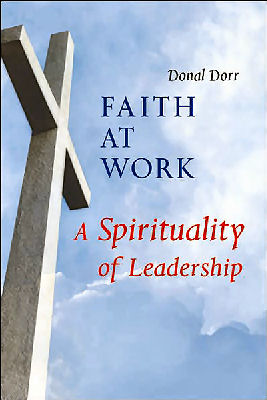
|
Posted April 24, 2007
Book: Faith at Work: A Spirituality of Leadership Author: Donal Dorr Liturgical Press. Collegeville, MN. 2006. Pp. 171 An Excerpt from the Jacket:
Dorr focuses on scriptural sources for a spirituality of leadership and draws insights from various spiritual traditions in the history of the church. He emphasizes the surprisingly strong and consistent democratic tradition within Christianity. He also draws on key elements in the thinking of political philosophers and management theorists. In the heart of the book the author describes four different kinds of leaders and outlines five styles or manners in which good leadership is exercised. Dorr concludes with a discussion of techniques for individual and communal discernment and the use of intuition in decision making. An Excerpt from the Book: Arnold Mindell’s Approach to Leadership I want now to look at the work of a more recent thinker and innovator who has some fascinating ideas about leadership. Arnold Mindell comes from a New York Jewish background. He worked for some years in Zurich as a Jungian psychotherapist. Then he broadened his approach very considerably. From the point of view of leadership, the most significant of his innovations was his development of a process he calls “worldwork.” This is a special type of workshop in which large groups of people tackle major sociopolitical issues such as racial prejudice, deep ethnic animosity arising from past or recent wars, gender issues, homophobia, and various other forms of prejudice. Mindell’s approach has a lot in common wit that of Freire. One major point of similarity is that both Freire and Mindell emphasize the importance of strong feelings. Both are aware that the way effective change comes about is above all through the channeling of such strong emotions. Because it takes the expression of feelings so seriously, Mindell’s approach calls in question the usual rules (explicit or implicit) governing debate and dialogue. He encourages participants in his workshops to give expression to their strong feelings. This means that at times the atmosphere can get very heated and at other times people may be reduced to tears. The result is that the power in the group tends to shift from those who are good at thinking on their feet and expressing themselves clearly. The power moves more to those who feel passionately on certain issues and are willing to express these feelings in the group — even if they are not very good at putting them into nicely balanced words. This also has important consequences in relation to how leaders (and others) can best manage conflict. First of all, they have to recognize that sometimes it is better not to try to put a lid on the expression of strong feelings. Second, they should accept that it is more helpful to think in terms, not of conflict resolution but of managing conflict — which may mean helping the group to live with the discomfort of divergent views. Third, in so far as there is a resolution of the conflict, it does not always come through the careful rational working out of a consensus position. Sometimes it is more likely to come through a kind of catharsis, that is, a release of high emotional tension in which people from opposite sides of the fence find themselves drawn together by a shared sympathy that enables them to accept each otehr in all their differences. Table of Contents: 1. Biblical aspects 2. The Christian tradition 3. Authority and leadership since Vatican II 4. Political and psychological thinking 5. The limits of democracy 6. Leadership in management theory 7. Four kinds of leaders 8. Styles of leadership 9. Vision and call 10. Some practical aspects of leadership 11. Personal discernment and decision making 12. Intuition as a basis for discernment 13. Communal discernment and decision makng Appendix: “Consolation without Cause” |
|
